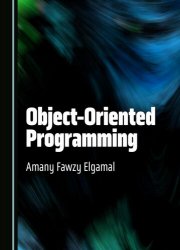Object-Oriented Programming
- Добавил: literator
- Дата: 11-03-2024, 18:27
- Комментариев: 0
 Название: Object-Oriented Programming
Название: Object-Oriented ProgrammingАвтор: Amany Fawzy Elgamal
Издательство: Cambridge Scholars Publishing
Год: 2024
Страниц: 157
Язык: английский
Формат: pdf (true)
Размер: 10.1 MB
This book explores the concepts of object-oriented programming, which have become the cornerstone of most programming languages. The book introduces the meaning of classes and objects, inheritance, encapsulation, and polymorphism. It also contains examples of Unified Modeling Language (UML) that enable the reader to model systems. The book explains these concepts in a simple manner and includes the application of these concepts through a large number of examples in three different programming languages: C#, VB.Net, and Python. The concepts introduced in the book are applicable to any programming language which supports object-oriented programming. The book is an indispensable resource that will enhance its readers’ system development skills.
In Structured Programming, a program is comprised of a set of instructions. Small programs are generally easy to understand, but larger ones, containing hundreds of statements, can be difficult to comprehend unless they are divided into smaller parts. Consequently, functions and procedures are utilized to make these programs easier to read and understand.
The standard approach to designing software systems involves identifying the problem, and then developing a set of functions that can accomplish the required tasks. If these functions are too complex, they are further broken down until they become simple enough to understand. This process is known as functional decomposition.
To solve problems facing programmers, such as the one mentioned above, the concept of Object-Oriented Programming (OOP) is adopted. Two related issues are the absence of any restrictions on functions accessing global data in the program, and the lack of a complete connection between the functions and data, which is at odds with practical reality. Thus, in OOP, the data and the operations that can be performed on it are combined into a single entity, making it easier to understand how a program works. Additionally, OOP provides several benefits such as encapsulation, inheritance, and polymorphism that make it easier to design, implement, and manage software systems.
Unified Modeling Language (UML) is a visual modeling language that provides developers (working in the field of analysis and design of object-oriented systems) with diagrams and methods to visualize, create, and document software systems, and to model the organizations that use these systems. Note that it is not a way to build or develop systems; it will not direct them on what to do first and what to do next. It will not tell you how to design the system but it will help you with modeling.
Скачать Object-Oriented Programming
Внимание
Уважаемый посетитель, Вы зашли на сайт как незарегистрированный пользователь.
Мы рекомендуем Вам зарегистрироваться либо войти на сайт под своим именем.
Уважаемый посетитель, Вы зашли на сайт как незарегистрированный пользователь.
Мы рекомендуем Вам зарегистрироваться либо войти на сайт под своим именем.
Информация
Посетители, находящиеся в группе Гости, не могут оставлять комментарии к данной публикации.
Посетители, находящиеся в группе Гости, не могут оставлять комментарии к данной публикации.
